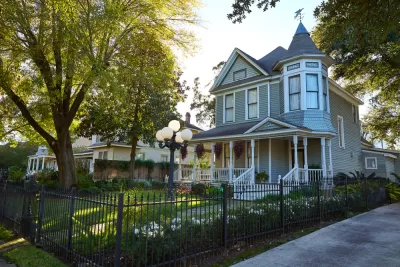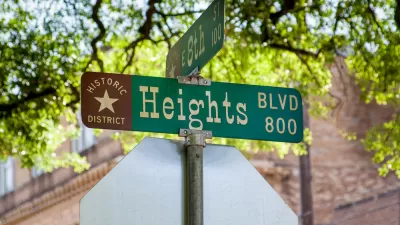A proposal by the city’s mayor would create a new type of preservation district designed to protect historic structures and slow gentrification.

Critics of a proposal by Houston mayor Sylvester Turner to create ‘conservation districts’ that would protect historic structures and enable infill development in historic neighborhoods in the traditionally zoning-averse city say the mayor’s plan won’t stop gentrification and could hinder new housing construction, reports Yilun Cheng in the Houston Chronicle.
According to Anika Singh Lemar, a Yale Law School professor who studies land use, zoning, and housing issues, “regulating the density or appearance of new housing construction does not make a gentrifying area less desirable and will lead to even less affordability due to the artificial constraints on the local housing supply.”
While the ordinance has not yet been passed by the city council, some neighborhood groups are eager to take advantage of the program once it’s in place. As Cheng writes, “Freedmen’s Town, Independence Heights, Magnolia Park and Manchester could be among the first areas to participate in the program, if it is approved by council, according to Wallace Brown.”
Supporters of the program say it could help communities preserve historic architecture and maintain ‘neighborhood character’ while allowing for new development. Margaret Wallace Brown, director of Houston’s Planning and Development Department, says that conservation districts could be less complicated for property owners by having more flexible requirements for historic preservation that make it easier to preserve older housing.
The ordinance will likely be voted on by the full city council this month.
FULL STORY: Turner wants to fight Houston gentrification with conservation districts. Critics say it won't work.

Study: Maui’s Plan to Convert Vacation Rentals to Long-Term Housing Could Cause Nearly $1 Billion Economic Loss
The plan would reduce visitor accommodation by 25,% resulting in 1,900 jobs lost.

North Texas Transit Leaders Tout Benefits of TOD for Growing Region
At a summit focused on transit-oriented development, policymakers discussed how North Texas’ expanded light rail system can serve as a tool for economic growth.

Why Should We Subsidize Public Transportation?
Many public transit agencies face financial stress due to rising costs, declining fare revenue, and declining subsidies. Transit advocates must provide a strong business case for increasing public transit funding.

How to Make US Trains Faster
Changes to boarding platforms and a switch to electric trains could improve U.S. passenger rail service without the added cost of high-speed rail.

Columbia’s Revitalized ‘Loop’ Is a Hub for Local Entrepreneurs
A focus on small businesses is helping a commercial corridor in Columbia, Missouri thrive.

Invasive Insect Threatens Minnesota’s Ash Forests
The Emerald Ash Borer is a rapidly spreading invasive pest threatening Minnesota’s ash trees, and homeowners are encouraged to plant diverse replacement species, avoid moving ash firewood, and monitor for signs of infestation.
Urban Design for Planners 1: Software Tools
This six-course series explores essential urban design concepts using open source software and equips planners with the tools they need to participate fully in the urban design process.
Planning for Universal Design
Learn the tools for implementing Universal Design in planning regulations.
City of Santa Clarita
Ascent Environmental
Institute for Housing and Urban Development Studies (IHS)
City of Grandview
Harvard GSD Executive Education
Toledo-Lucas County Plan Commissions
Salt Lake City
NYU Wagner Graduate School of Public Service





























